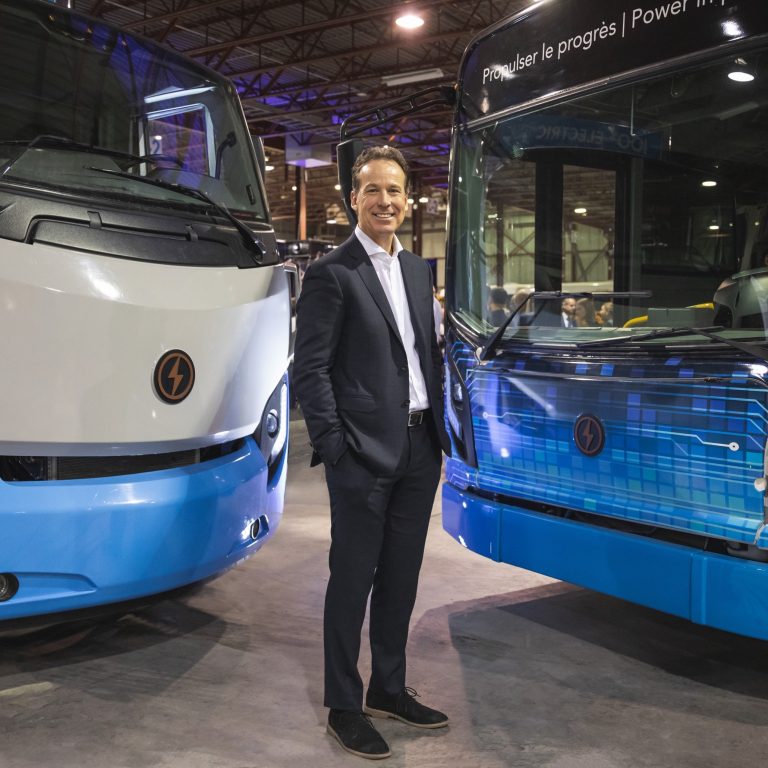The Transition to a Net-Zero Transportation Sector Is Happening Now
“Ambitious action is required to tackle the climate crisis, and the time to act is now.”

Over the past two weeks, thousands of government delegates and members of civil society, business and the media have gathered at the COP26 Climate Conference in Glasgow to advance climate action. Against an unprecedented volume of national and corporate pledges and commitments, UN Secretary-General, António Guterres noted that aligning with a 1.5° C warming scenario “requires greater ambition on mitigation and immediate concrete action to reduce global emissions.”[i]
To transition to a low-carbon economy swiftly, we need to tackle significant emission sources. In North America, the transportation sector is one of the largest contributors to GHG emissions.[ii] In particular, medium- and heavy-duty vehicles, like buses and trucks, account for nearly 40% of transportation-related emissions, and freight emissions are growing so much so that they are poised to exceed those from passenger vehicles by 2030.[iii] In its watershed report on how to transition to net-zero, the International Energy Agency noted earlier this year that electric buses and heavy-duty trucks will need to represent 79 and 59 percent of global vehicle fleet respectively by 2050.[iv] To put this in perspective, those fleets are not even close to one percent zero-emission today.
Zero-emission vehicles (ZEVs) will play an essential role in helping the United States and Canada reach their net-zero targets by 2050. For their part, automakers have pledged to phase out internal combustion engines in the next decade or so for passenger vehicles. G.M., Daimler and Ford, for example, have all promised to sell only zero-emission vehicles by 2035. This is an enormous post-industrial shift, and one that will keep emissions out of the atmosphere for decades to come. But these actions alone will not be sufficient to stem the tide. Similarly ambitious action is needed for buses and freight vehicles; a decarbonization opportunity that is too significant to ignore.
Over the past year, states, provinces, cities and municipalities across North America have started enacting regulations to decarbonize medium- and heavy-duty vehicles. In California, the Advanced Clean Truck regulation set forth plans to accelerate zero-emissions trucking through manufacturer sales requirements and reporting requirements for corporate fleets.[v] New York State looks to be following suit.[vi] In its most recent election, the Liberal Party of Canada promised to introduce national sales targets for medium- and heavy-duty vehicles requiring 100% of sales to be zero emission by 2040, where feasible.[vii] Provincially, British Columbia’s new Climate Action Plan promises to establish similar sales targets[viii], and Quebec has committed to electrifying 55% of city buses and 65% of school buses by 2030.[ix]
The positive momentum is undeniable. But we, at Lion Electric, believe that the time to transition to all-electric vehicles is now.
As an established manufacturer of zero-emissions vehicles, with proven technology and approximately 450 vehicles which have logged more than 8 million miles on North American roads, we are making a difference today. Our all-electric urban trucks are viable zero-emissions replacements for heavy-duty vehicles that otherwise pollute city air with stop-and-go traffic in congested, populated areas. Our electric school buses provide reliable transportation for our youngest generation without the health hazards of idling emissions. In other words, all the vehicles we currently have available for sale, are dependable, proven solutions.
As COP26 just ended, the need to take immediate action to decarbonize transportation is clear. Electrifying medium- and heavy-duty vehicles is an integral part of achieving net-zero emissions and transitioning to a low-carbon economy. We, at Lion Electric, stand ready to support companies and communities looking to make this positive change and prepare themselves for the future.

[i] Secretary-General’s remarks to the World Leaders Summit – COP 26 [as delivered] [scroll down for French version] | United Nations Secretary-General
[ii] https://www.epa.gov/ghgemissions/sources-greenhouse-gas-emissions; https://www.cer-rec.gc.ca/en/data-analysis/energy-markets/market-snapshots/2016/market-snapshot-increased-ghg-emissions-from-transportation-sector-reflect-major-consumer-business-trends.html
[iii] https://unfccc.int/sites/default/files/resource/br4_final_en.pdf
[iv] Net Zero by 2050 – Analysis – IEA
[v] https://ww2.arb.ca.gov/resources/fact-sheets/advanced-clean-trucks-fact-sheet
[vi] https://www.governor.ny.gov/news/advance-climate-week-2021-governor-hochul-announces-new-actions-make-new-yorks-transportation
[vii] https://liberal.ca/wp-content/uploads/sites/292/2021/09/Platform-Forward-For-Everyone.pdf
[viii] https://www2.gov.bc.ca/gov/content/environment/climate-change/clean-transportation
[ix] https://www.quebec.ca/en/government/policies-orientations/plan-green-economy
